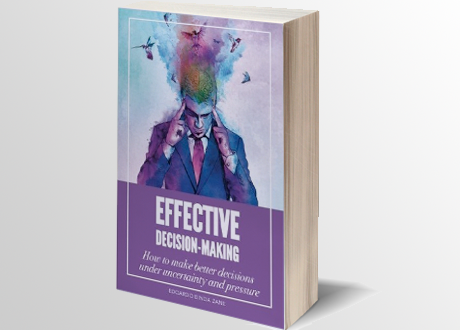By: Amelia Johannsen
Corporate managers and entrepreneurs alike are accustomed to making tough decisions and seeking out the best possible solutions to everyday problems. It comes with the territory, but it’s not inherently easy. In order to reach a leadership position or own a company you probably have a knack for decision-making, but when the future of a business depends on the outcome, it’s important to reduce cognitive biases and calculate carefully.
Berlin-Based business coach, Edoardo Binda Zane has recently authored a new book, Effective Decision-Making: How To Make Better Decisions Under Uncertainty And Pressure providing 44 actionable tools for making better decisions. The book is intended as a resource for people in leadership and strategic management roles, thus timing and complexity are always taken into consideration.
Besides the usefulness of the methods provided, what I enjoyed about this book is the straightforward, matter-of-fact style in which it was written. Binda Zane does not waste time on background stories or anecdotes; explaining that, “the contents are conditioned by my opinions of what does and does not work in a fast-paced and constrained world.” (Binda Zane, 2016) He provides as much explanation as needed to put the methods to work. When necessary, Binda Zane breaks complex ideas down into bite-size pieces so that it can be easily and quickly put into action.
The layout complements its usefulness as a practical reference to keep on-hand. There’s plenty of white space for notes and comments as you try out the different techniques.
Your brain messing with you
The introduction is brief, but it packs a powerful punch. Each individual is the center of his or her own little universe and everyone needs to be reminded of their cognitive biases in order learn, grow and make successful decisions in life. Binda Zane chose to feature the Confirmation bias and the Dunning-Kruger effect to highlight the need for his book.
There’s no such thing as on-call creativity
Another powerful argument Binda Zane makes is the ineffectiveness of brainstorming due to the fact that social factors heavily inhibit group creativity. While the concept behind brainstorming is “brilliant,” he says that it usually produces a “sub-par list of ideas brought forward by the most extroverted members of the group.” (Binda Zane, 2016)
I think the book provides a fair assessment of the standard corporate brainstorming session where managers are dragged in to a boardroom and confronted by an enthusiastic facilitator who asks them to come up with new ideas on-cue. However, there are environments where brainstorming techniques work well, and Binda Zane does go on to describe the ideal —and very rare —circumstances where brainstorming sessions produce successful results.
Frameworks and tools
The tools are grouped together in a logical structure:
- Frameworks of reference
- Separate phases of decision making; from the environment and problem to generating solutions and the selection process
- Group decision-making; should your team be involved? If so, how?
- Corporate strategy design and analysis of consequences / impact.
Wrapping-up
To improve any of your skills you must practice them as well as explore different styles and methods. That doesn’t mean you have to perfect or even use all of the options available to you. But you will learn something new by trying. Decision-making is no different. There are many ways to go about it and plenty of pitfalls to derail you. Effective Decision Making is an powerful resource to help you improve this vital skill.
By Amelia Johannsen
From the author
 “We always make decisions under uncertainty and pressure, especially in business. We need faster and better decisions to cope, but we don’t have the time to learn how to make them well. That is where I come in. I wrote this book to allow you to make better decisions without spending weeks studying theory and practice.” Learn more >
“We always make decisions under uncertainty and pressure, especially in business. We need faster and better decisions to cope, but we don’t have the time to learn how to make them well. That is where I come in. I wrote this book to allow you to make better decisions without spending weeks studying theory and practice.” Learn more >
About the reviewer
 Amelia Johannsen is a digital communications professional working on a variety of projects internationally. She is passionate about functional design and collaborative innovation used to create a more compassionate and sustainable world. As a freelance writer, she contributes to projects such as InnovationMangement.se, The Green Exchange and Handmade Barcelona, while her free time is best spent traveling and in the pottery studio. Feel free to connect on Linkedin.
Amelia Johannsen is a digital communications professional working on a variety of projects internationally. She is passionate about functional design and collaborative innovation used to create a more compassionate and sustainable world. As a freelance writer, she contributes to projects such as InnovationMangement.se, The Green Exchange and Handmade Barcelona, while her free time is best spent traveling and in the pottery studio. Feel free to connect on Linkedin.

